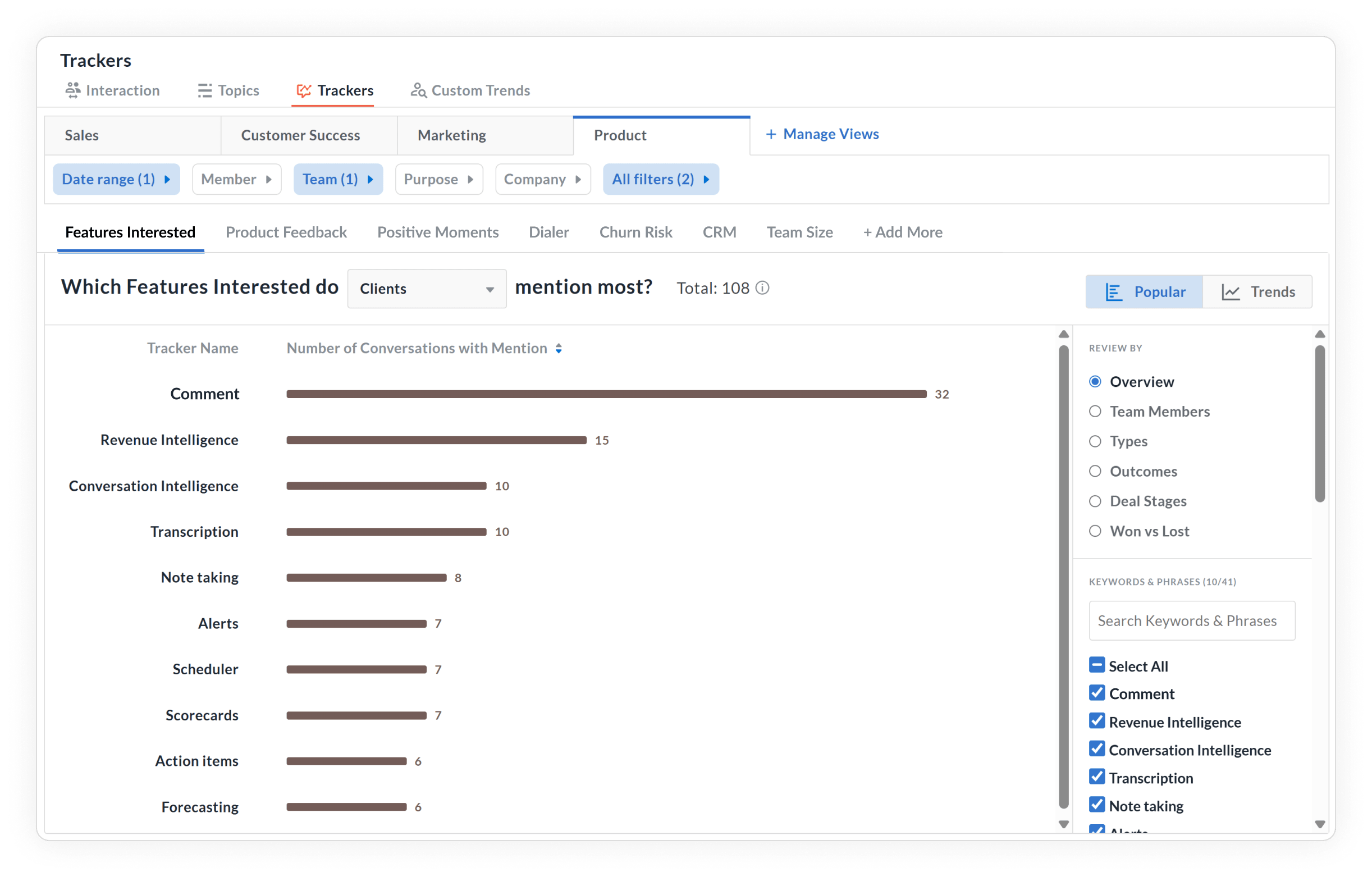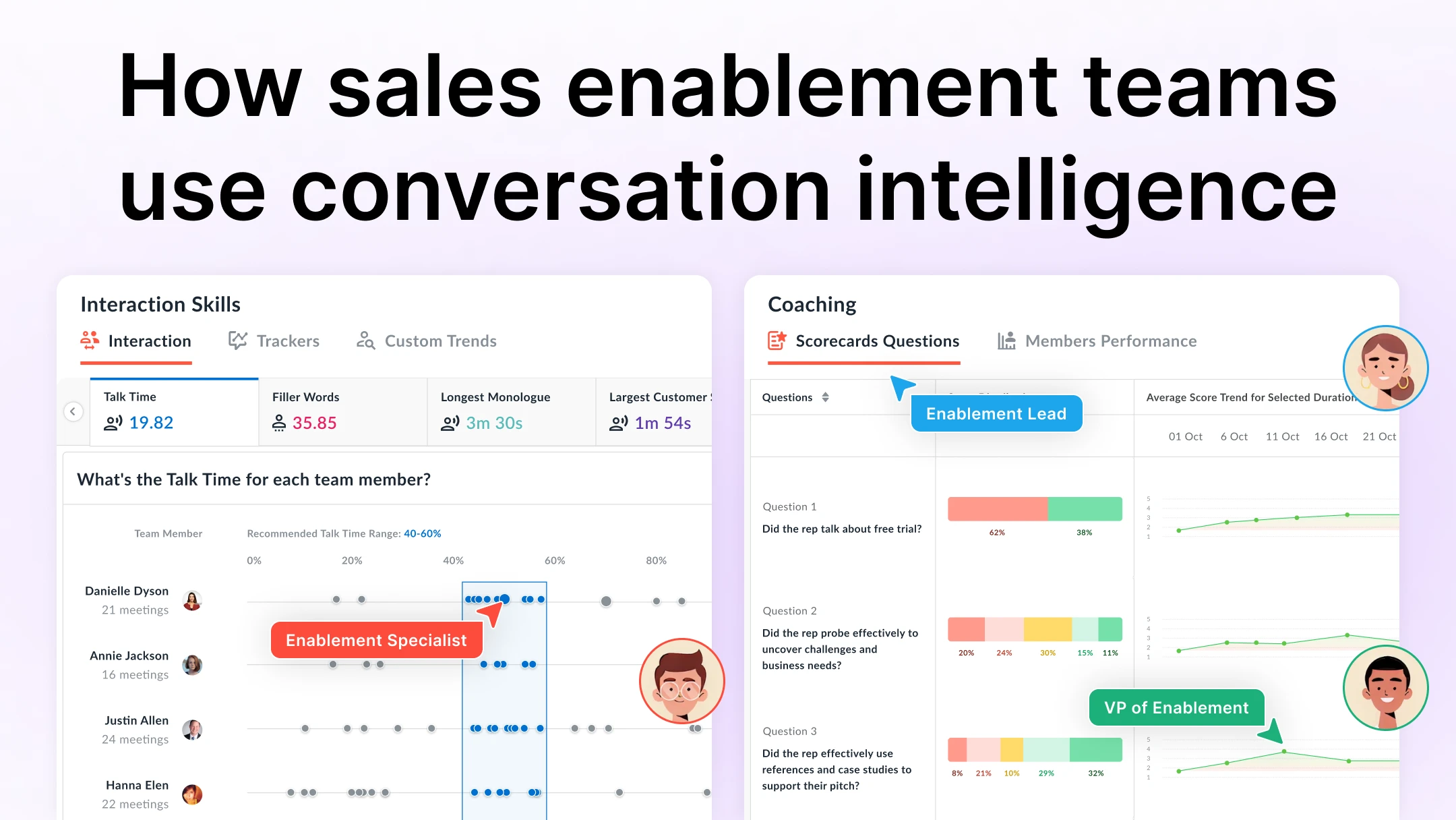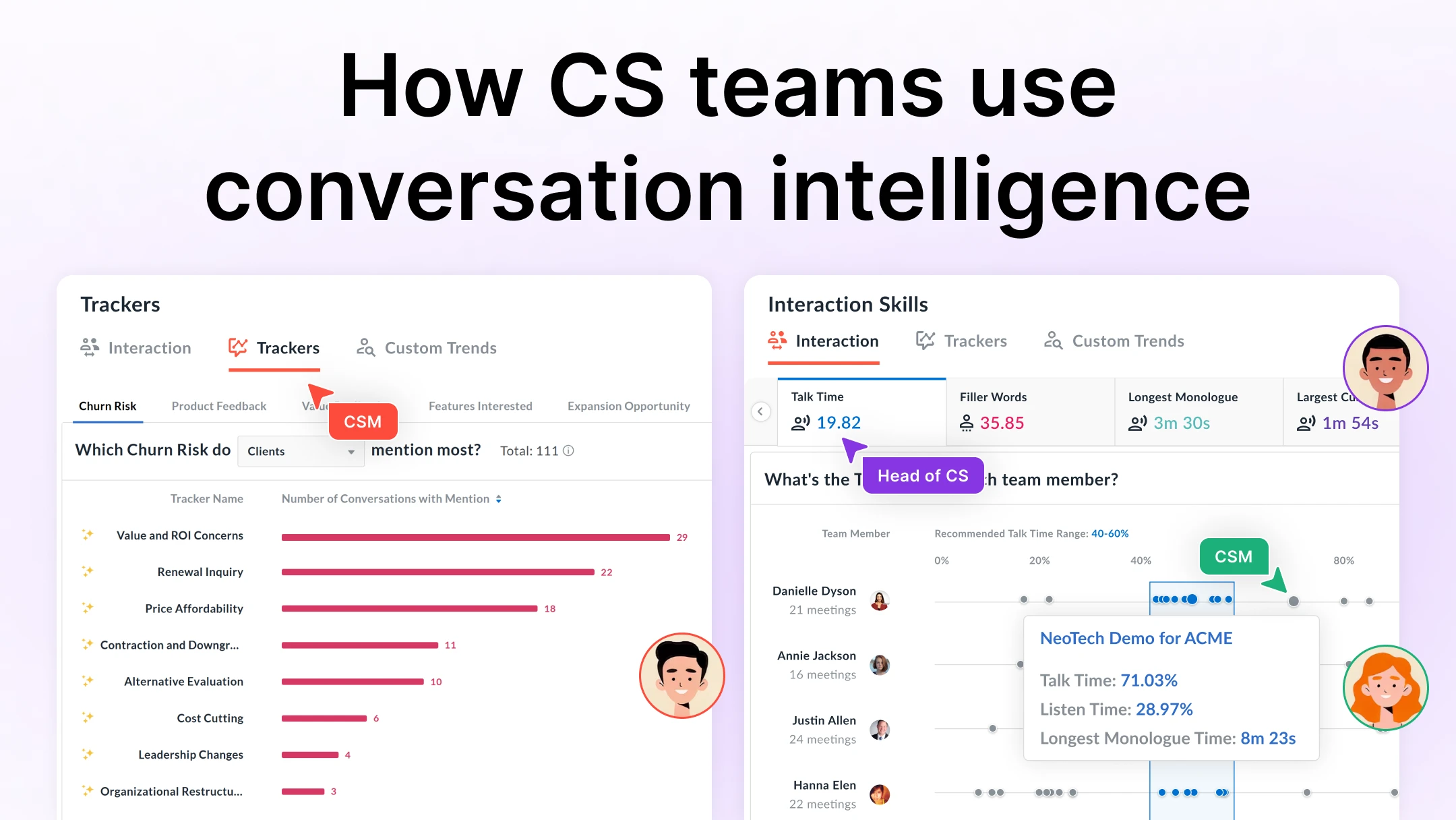How Product Marketing teams use conversation intelligence
Table of Contents:

Product marketing teams use conversation intelligence to shape positioning, launch messaging, and roadmap decisions using what customers say in calls and demos. It captures problem statements, buying criteria, and recurring objections. Product marketing managers use these insights to rewrite message pillars, launch assets, and prioritize features.
In this article, we highlight key conversation intelligence use cases for PMMs and how it empowers them to achieve their GTM goals.
Key takeaways
- Validate GTM messaging in 1–2 weeks (not 2–3 months) by reviewing early calls and fixing naming, story, and enablement fast.
- Build sharper messaging from buyer language: capture problem statements, buying criteria, and objections, then reuse clips in page copy and decks.
- Improve competitive outcomes by tracking competitor mentions and objection patterns, and refreshing battlecards with short, linked snippets.
- Guide roadmap and pricing with evidence by rolling up requests and friction by persona and segment to set priorities and value metrics.
What are the key conversation intelligence use cases for Product Marketers
Conversation intelligence software empowers product marketers to validate GTM messaging in just a couple of weeks instead of months. It speeds up content production and tightens alignment with cross functional teams.
Let’s learn about the key use cases of conversation intelligence for product marketers.
Voice of customer and messaging
- Mine recurring problem statements, desired outcomes, and exact phrases from calls to anchor positioning and page copy.
- Tag moments that reveal value drivers and pain intensity so writers can reuse language directly in assets.
- Build a snippet library of short clips and examples so cross-functional teams align on the same proof.

Competitive intelligence
- Track competitor mentions by stage and segment to learn where comparisons arise and why outcomes tilt.
- Capture customer objection so battlecards and messaging reflect how buyers frame concerns.
- Circulate short clips with context so teams learn quickly without scrubbing long recordings.

Launch readiness and post-launch monitoring
- Set topic alerts for new features and review early calls to confirm the value story lands as intended.
- Detect confusion signals, then update demos, FAQs, and one-pagers and redeploy within the first week.
- Keep a running list of before-and-after clips to show what changed and why.
Product roadmap and UX feedback
- Aggregate feature requests and friction points by persona to size demand and prioritize with evidence.
- Attach short call clips to PRDs so engineering and design hear the problem in the customer’s words.
- Recheck conversations after release to confirm that changes resolved the issue.
Pricing and packaging signals
- Analyze late-stage calls to spot discount triggers and proof points that move deals forward.
- Capture the language buyers use to justify price so value metrics and tier boundaries reflect reality.
- Share a monthly summary with Finance and Sales that links findings to clips for fast context.
Segmentation and ICP refinement
- Compare themes by industry, company size, and region to see which pains concentrate by segment.
- Document how each persona frames the problem and which outcomes they prioritize.
- Feed insights into vertical pages, campaigns, and channel plans to improve match quality.
Churn and expansion with CS
- Review renewal and QBR conversations to identify adoption gaps, unmet needs, and upsell cues.
- Tie evidence to onboarding and in-app help so time-to-value improves and risk declines.
- Track which save messages resonate, then standardize the highest-impact language.
How PMMs can get started with conversation intelligence with Avoma
Here's a checklist to help your product marketing teams to capture conversations and drive GTM strategies with Avoma.
Turn on capture
- Connect your calendar and meeting apps to auto-record Sales/CS calls.
- Use Avoma to start recording calls
Create a short tag list
- In Avoma, add Topics/Keywords for problems, benefits, objections, and buying steps (keep to 10–15).
- Share the tag list in your workspace so everyone labels moments the same way.
Save snippets
- Open recent call transcripts in Avoma, highlight 15–30 second moments, and save as Snippets.
- Name snippets with buyer words + persona + stage for quick search.
Build one playlist and share
- Create a Playlist in Avoma (e.g., “Voice of Customer").
- Share the playlist link with Content, Product, Enablement, and CS teams.
Ship one asset update
- Pull phrasing from snippets to update a message pillar, battlecard section, or launch FAQ.
- Paste Avoma snippet links into your doc/PRD for context.
Review and plan next week
- In Avoma, scan Topic trends and recently saved snippets.
- Merge duplicate tags, note the top two insights, and pick the next asset to update
Final thoughts
Conversation intelligence delivers measurable gains for product marketing. With Avoma, teams report 30% faster message testing cycles, 25% better win–loss accuracy after listening to buyer conversations, and GTM messaging validated in 1–2 weeks instead of 2–3 months. Use these gains to ship clearer messaging, stabilize launches sooner, and prioritize features with evidence. High-performing product marketing teams use Avoma to stay ahead of the competition. To empower your PMMs get in touch with our experts and see our platform live in action.
Frequently Asked Questions
Conversation intelligence software records and transcribes Sales/CS calls, then surfaces buyer problem statements, evaluation criteria, recurring objections, and decision steps. PMMs use these findings to rewrite messaging, update launch assets, refresh battlecards, and feed PRDs—with linked snippets and summaries that anyone on GTM or Product can review.
Measure ROI by comparing before vs. after on three dimensions: speed (time to update messaging), effectiveness (win/loss and objection resolution), and efficiency (campaign CTR/CVR and hours saved from notes/search). Attribute each gain to conversation evidence by logging: finding from calls → asset you changed → metric that improved
Buyer questions like “what does this replace?” and “how is it different,” confusion about feature names or workflow fit, and risk concerns on implementation, integrations, security, or pricing/packaging are the key signals. If these rise in early calls, expect adoption friction; fix naming, tighten the value story, and update enablement before general availability.




Dive into Our Latest
Avoma Insights.


What's stopping you from turning every conversation into actionable insights?









